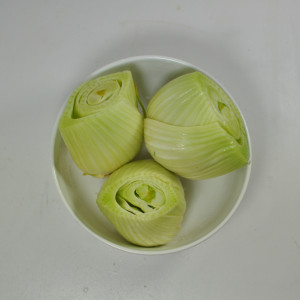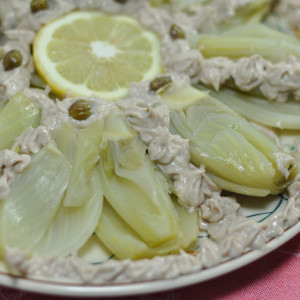Steamed fennel
Not everyone loves steamed or boiled vegetables, but it is clear that they are very good for everyone’s health! So we should try to eat them when we can and, as they say, try to have it both ways by flavouring them or making them especially delicious with the help of some special seasoning or a sauce. Today we reveal a secret - the combination of fennel and tuna is really superb. We will also explain how to make an amazing sauce made from tuna (vaguely reminiscent of the classic tuna sauce, but not quite the same …), perfect for mixing with and or accompanying the steamed fennel that many of you would probably find sad and bland on its own. If you like the idea, you can use this same sauce for combining with other types of steamed vegetable such as courgette, cabbage, carrot or whatever. Here’s the recipe then: a little secret that will become a staple in your kitchen, light but with taste!
Ingredients

Send the recipe
Preparation
Peel and cut the fennel into 4 wedges, wash and steam them for about 20 minutes. Blend the tuna, anchovy fillets, capers, ricotta, lemon juice, salt and pepper until the mixture is creamy. Serve the fennel with this creamy sauce.
Step by step
|
View the step by step

|
Wash and peel the fennel
|
|
View the step by step

|
Divide the fennel into 4 sections
|
|
View the step by step

|
Put the ricotta, the tuna, the anchovies, the capers, the lemon juice, and the salt and pepper in a blender
|
|
View the step by step

|
Blend until you get a smooth, aromatic and creamy mixture
|
|
View the step by step

|
Serve the fennel with the creamy sauce, perhaps using a pastry bag to decorate the plate
|
|
View the step by step

|
Here they are, your steamed fennel are ready to serve
|
Additional Information
Steamed fennel time? How long to steam fennel?
Steaming fennel is a simple and healthy way to enjoy this versatile vegetable. To steam fennel, first, trim off the fronds and tough outer layer. Then, slice the fennel bulb into wedges or slices. Place the fennel in a steamer basket over boiling water and cover. Steam for about 10-15 minutes, or until the fennel is tender when pierced with a fork. The exact steaming time may vary depending on the thickness of the slices and your desired level of tenderness.
Steamed fennel recipes
Steamed fennel can be enjoyed on its own as a flavorful side dish or incorporated into various recipes. One simple recipe is to drizzle steamed fennel with olive oil and sprinkle with salt, pepper, and fresh herbs like thyme or parsley. Another option is to toss steamed fennel with lemon juice and Parmesan cheese for a zesty twist. You can also add steamed fennel to salads, pasta dishes, or grain bowls for added flavor and nutrition.
Can you steam fennel?
Yes, you can steam fennel! Steaming is a great cooking method for fennel as it helps to retain its natural flavors and nutrients while creating a tender texture. Steamed fennel makes a delicious and healthy addition to any meal and can be seasoned with a variety of herbs and spices to suit your taste preferences.
Calories in steamed fennel
Steamed fennel is a low-calorie vegetable that's packed with flavor and nutrients. One cup of sliced, steamed fennel contains approximately 27 calories, making it a great choice for those looking to maintain a healthy diet. Fennel is also high in fiber, vitamin C, and potassium, making it a nutritious addition to your meals.
Fennel recipes
Fennel is a versatile vegetable that can be used in a variety of recipes. In addition to steaming, fennel can be roasted, sautéed, grilled, or eaten raw. Some popular fennel recipes include fennel and orange salad, roasted fennel with Parmesan, fennel and leek soup, and grilled fennel with balsamic glaze. Experimenting with different cooking methods and flavor combinations can help you discover new and delicious ways to enjoy fennel.
How to cook fennel quickly
If you're short on time, there are a few quick cooking methods you can use to prepare fennel. Slicing fennel thinly and sautéing it in olive oil over medium heat is a fast and delicious option. You can also roast fennel at a high temperature for about 20-25 minutes until tender and caramelized. Another quick cooking method is to blanch fennel in boiling water for a few minutes until slightly softened, then finish cooking it in a sauté pan with your favorite seasonings.
How long to boil fennel?
Boiling fennel is a simple way to cook this versatile vegetable, but it's important not to overcook it to maintain its flavor and texture. To boil fennel, start by trimming off the fronds and tough outer layer, then slice the fennel bulb into wedges or slices. Place the fennel in a pot of boiling water and cook for about 5-7 minutes, or until tender when pierced with a fork. Be sure to check the fennel frequently to avoid overcooking, as it can become mushy if boiled for too long.
What is fennel?
Fennel is a crunchy, aromatic vegetable that belongs to the carrot family. It has a bulbous base, long green stalks, and feathery fronds. Fennel has a mild, slightly sweet flavor with hints of licorice, making it a unique and versatile ingredient in both savory and sweet dishes. The entire fennel plant is edible, including the bulb, stalks, and fronds, and it can be enjoyed raw or cooked in a variety of recipes. Fennel is also prized for its medicinal properties and has been used for centuries to aid digestion and freshen breath.
What is the best way to eat fennel?
The best way to eat fennel is either raw or cooked. Raw fennel can be sliced thinly and added to salads for a crisp, refreshing crunch, while cooked fennel can be roasted, grilled, or braised to bring out its sweet, aromatic flavor.
Is fennel good cooked?
Yes, fennel is delicious when cooked. Cooking fennel helps to mellow its flavor and brings out its natural sweetness. It can be roasted, grilled, sautéed, or even braised to create flavorful dishes.
Can I boil fennel?
Yes, you can boil fennel, although it's not as common a cooking method as roasting, grilling, or sautéing. Boiling fennel can soften it and reduce its intensity, making it more suitable for certain dishes or preparations. However, boiling can also cause fennel to lose some of its flavor and nutrients, so it's not always the preferred method of cooking.
Why do chefs use fennel so much?
Chefs use fennel frequently because it adds a unique flavor and texture to dishes. Fennel has a distinct anise-like flavor that can enhance both savory and sweet dishes. It also has a crisp texture when raw and becomes tender and caramelized when cooked, providing versatility in culinary applications. Additionally, fennel is known for its health benefits, as it is low in calories, high in fiber, and contains various vitamins and minerals, making it a popular choice for chefs looking to create flavorful and nutritious dishes.




